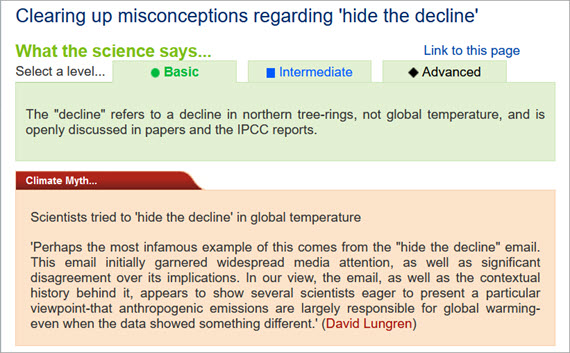
On February 14, 2023 we announced our Rebuttal Update Project. This included an ask for feedback about the added "At a glance" section in the updated basic rebuttal versions. This weekly blog post series highlights this new section of one of the updated basic rebuttal versions and serves as a "bump" for our ask. This week features "Clearing up misconceptions regarding 'hide the decline'". More will follow in the upcoming weeks. Please follow the Further Reading link at the bottom to read the full rebuttal and to join the discussion in the comment thread there.
It's been many years since 'climategate' - when in 2009, the email server at the Climate Research Unit, University of East Anglia, was hacked. The unidentified hacker helped themselves to thousands of emails. These were sifted through and a selection was in due course made available for public download on a Russian server.
What followed was typical of the tactics used in the campaign to deny the existence of human-caused climate change and is illustrative for that reason. A lot of this manufactured controversy centred on one email, written by Dr Phil Jones, in which the following sentence was picked out and trumpeted all over the media:
"I've just completed Mike's Nature trick of adding in the real temps to each series for the last 20 years (ie from 1981 onwards) and from 1961 for Keith's to hide the decline."
"Gotcha!", the deniers proclaimed.
Climategate was marketed to the public by encouraging them to take such sentences at face value - without any idea of what they actually meant. The notion being planted was that climate scientists were busy covering up declining temperatures.
It meant nothing of the sort. The people in that email were not talking about temperatures. They were talking about tree-rings.
"Mike's Nature trick" referred to a technique described in a 1998 Nature paper. The paper presented a 600 year-long global temperature reconstruction by Michael Mann and colleagues. Michael has long used tree-ring growth patterns in ancient wood to reconstruct conditions at the time those rings formed. The basic idea is that in cold, dry years, trees grow more slowly so their rings are relatively narrow and densely-spaced. In warm wet years, it's the opposite.
The "trick" is the technique of plotting recent instrumental data - in other words direct temperature measurements - alongside the reconstructed tree-ring data for the time they overlap. Why? Because it's one way of checking if the reconstructed tree-ring data are a good proxy for temperatures of the past. It therefore makes entire sense to run such checks. Now to the 'decline'. What declined?
Beyond a certain point on the timeline, around 1960, the temperature reconstructions based on some tree-ring data fell away and downwards from observed thermometer records. They declined from reality. This only happened with certain tree-ring datasets from specific places. Known as the 'divergence problem', it had been discussed in the scientific literature since the mid 1990s - 15 years before 'climategate'. However, not a lot of people realised that. How lucky for the deniers. "Hide the decline!", they chanted feverishly, to anybody who would listen.
Everything that occurs in the physical world has a cause. The divergence of temperature reconstructions, based on tree-ring growth, from the observational temperature record is a case in point. The loss of tree-ring sensitivity to temperatures kicked in around 1960. It only affected certain tree-species at certain locations. However, in those cases the post-1960 tree-ring datasets do not reflect the actual conditions. In other words, the data are useless. That's the decline for you. Much ado about nothing.
Please use this form to provide feedback about this new "At a glance" section. Read a more technical version below or dig deeper via the tabs above!
In case you'd like to explore more of our recently updated rebuttals, here are the links to all of them:
If you think that projects like these rebuttal updates are a good idea, please visit our support page to contribute!
Posted by John Mason on Tuesday, 30 April, 2024
 |
The Skeptical Science website by Skeptical Science is licensed under a Creative Commons Attribution 3.0 Unported License. |